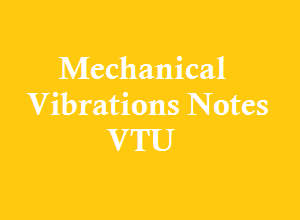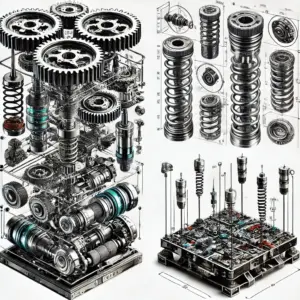Mechanical Vibrations Notes Pdf – MV VTU Pdf of Total Modules
Here you can download the Mechanical Vibrations VTU Notes Pdf – MV VTU Pdf Syllabus. Below we have list all the links as per the modules.
Mechanical Vibrations Notes Pdf – MV VTU Pdf of Total Modules
Please find the download links of Mechanical Vibrations Notes Pdf – MV VTU Pdf are listed below:

Mechanical Vibrations Notes PDF
Mechanical Vibrations Notes | PDF, Syllabus, Books | B Tech (2025)
Overview of MV Notes PDF
Mechanical Vibrations is a critical subject in the field of mechanical engineering, encompassing various types of vibrations and their applications. Vibrations are periodic back-and-forth movements of particles or systems. Understanding mechanical vibrations is essential for designing and analyzing various engineering systems, from simple structures to complex machinery. The lecture notes provided by VTU cover the fundamental and advanced concepts of mechanical vibrations, offering a comprehensive resource for B.Tech students.
The following topics are covered in Mechanical Vibrations handwritten Notes:
- Introduction to Types of Vibrations and Definitions
- Simple Harmonic Motion (S.H.M.) and Related Work
- Free Vibrations of Single Degree of Freedom Systems
- Damped Free Vibrations
- Forced Vibrations Analysis
- Vibration Measuring Instruments
- Systems with Two Degrees of Freedom
- Numerical Methods for Multi-degree Freedom Systems
- Modal Analysis and Condition Monitoring
Links to download Mechanical Vibrations Notes PDF
Below are the links to download the module-wise notes for Mechanical Vibrations:
PART A
- UNIT 1: Introduction to Vibrations
- UNIT 2: Free Vibrations (1DOF)
- UNIT 3: Damped Free Vibrations (1DOF)
- UNIT 4: Forced Vibrations (1DOF)
PART B
- UNIT 5: Vibration Measuring Instruments and Whirling of Shafts
- UNIT 6: Systems with Two Degrees of Freedom
- UNIT 7: Numerical Methods for Multi-degree Freedom Systems
- UNIT 8: Modal Analysis and Condition Monitoring
Mechanical Vibrations Notes and Study Material PDF Free Download
These notes are meticulously prepared to cater to the VTU syllabus for Mechanical Vibrations, providing a thorough understanding of each topic.
Topics Covered in this Mechanical Vibrations Notes PDF
The Mechanical Vibrations notes cover the following units and topics:
UNIT 1: Introduction to Vibrations
This unit introduces the types of vibrations, essential definitions, and fundamental concepts. Simple Harmonic Motion (S.H.M.) is discussed in detail, including the work done by harmonic forces. The principle of superposition applied to SHM, beats, and Fourier theorem are also covered, providing a solid foundation for understanding vibrations.
- Types of vibrations
- Definitions
- Simple Harmonic Motion (S.H.M.)
- Work done by harmonic force
- Principle of superposition applied to SHM
- Beats
- Fourier theorem and problems
UNIT 2: Free Vibrations (Single Degree of Freedom)
This unit focuses on free vibrations of single-degree-of-freedom systems. It covers derivations for spring-mass systems, various methods of analysis, and the natural frequencies of simple systems. The behavior of springs in series and parallel, torsional and transverse vibrations, and the effect of the mass of the spring are also discussed.
- Derivations for spring-mass systems
- Methods of analysis
- Natural frequencies of simple systems
- Springs in series and parallel
- Torsional and transverse vibrations
- Effect of the mass of spring
- Problems
UNIT 3: Damped Free Vibrations (1DOF)
Damped vibrations are essential in real-world applications where energy dissipation occurs. This unit covers types of damping, detailed analysis with viscous damping, and derivations for over-damped, critically damped, and under-damped systems. The logarithmic decrement method for determining damping is also included.
- Types of damping
- Analysis with viscous damping
- Derivations for over-damped, critically damped, and under-damped systems
- Logarithmic decrement
- Problems
UNIT 4: Forced Vibrations (1DOF)
This unit introduces forced vibrations and their analysis. It focuses on forced vibrations with constant harmonic excitation, including the magnification factor, and the effects of rotating and reciprocating unbalances.
- Introduction to forced vibrations
- Analysis of forced vibration with constant harmonic excitation
- Magnification factor
- Rotating and reciprocating unbalances
UNIT 5: Vibration Measuring Instruments and Whirling of Shafts
The unit covers seismic instruments used to measure vibrations, including vibrometers and accelerometers. Frequency measuring instruments are also discussed. Additionally, the unit delves into the whirling of shafts, both with and without damping, and the discussion of speeds above and below critical speeds.
- Seismic Instruments: Vibrometers, Accelerometers
- Frequency measuring instruments
- Whirling of shafts with and without damping
- Discussion of speeds above and below critical speeds
- Problems
UNIT 6: Systems with Two Degrees of Freedom
This unit explores systems with two degrees of freedom. It covers the principal modes of vibrations, normal modes, and natural frequencies of systems without damping. Simple spring-mass systems and masses on tightly stretched strings are used as examples.
- Principle modes of vibrations
- Normal mode and natural frequencies of systems (without damping)
- Simple spring-mass systems
- Masses on tightly stretched strings
UNIT 7: Numerical Methods for Multi-degree Freedom Systems
Numerical methods are crucial for analyzing complex systems. This unit introduces various numerical techniques, including Maxwell’s reciprocal theorem, influence coefficients, and Rayleigh’s method.
- Introduction to numerical methods
- Maxwell’s reciprocal theorem
- Influence coefficients
- Rayleigh’s method
UNIT 8: Modal Analysis and Condition Monitoring
Modal analysis and condition monitoring are essential for the maintenance and diagnosis of machinery. This unit covers signal analysis, dynamic testing of machines and structures, experimental modal analysis, and machine condition monitoring and diagnosis.
- Signal analysis
- Dynamic testing of machines and structures
- Experimental modal analysis
- Machine condition monitoring and diagnosis
Mechanical Vibrations Notes PDF from VTU
These notes are meticulously prepared to cater to the VTU syllabus for Mechanical Vibrations, providing a thorough understanding of each topic. The notes are comprehensive, with detailed explanations, derivations, and examples to aid in learning.
Always Choose Smartzworld to Download Mechanical Vibrations Notes PDF
Smartzworld offers a reliable platform to download the latest and most comprehensive study materials for B.Tech students. The notes are regularly updated to ensure they meet the current syllabus requirements and academic standards.
DOWNLOAD NOW
Benefits of FREE MV Handwritten Notes PDF
Downloading the handwritten notes for Mechanical Vibrations offers several benefits:
- Detailed explanations of concepts
- Step-by-step derivations and problem-solving techniques
- High-quality diagrams and illustrations
- Easy to understand and follow
- Free of cost, providing accessible resources for all students
Frequently Asked Questions (FAQs)
Q1. Where can I download the Mechanical Vibrations Notes PDF? You can download the notes from the provided links for each unit or the complete set from Smartzworld.
Q2. How to download the MV Notes PDF? Click on the provided links for each unit or the complete set to download the PDF files.
Q3. How many modules are covered in MV Notes PDF? The notes cover a total of 8 modules.
Q4. What topics are covered in MV Notes PDF? The notes cover topics such as types of vibrations, free and forced vibrations, damped vibrations, vibration measuring instruments, and more.
Q5. Where can I get the complete MV Handwritten Notes PDF FREE Download? You can get the complete notes for free download from Smartzworld.
Q6. How to download MV Handwritten Notes PDF? Follow the provided links to download the handwritten notes in PDF format.
Q7. How to Download FREE MV Notes PDF? You can download the free MV notes PDF from the provided links or from Smartzworld’s website.


